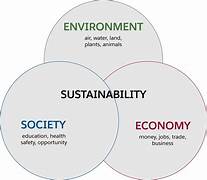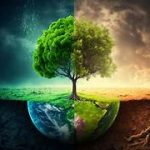Sustainable Development and Economic Growth: Achieving a Balance
In recent years, the conversation around economic growth has expanded to include concerns about the environment, social well-being, and long-term sustainability. Traditional economic growth models focused on increasing output and productivity without much regard for the environmental or social consequences. However, the need for a more balanced approach to development has become increasingly evident as global challenges such as climate change, resource depletion, and inequality intensify. Sustainable development, which seeks to harmonize economic growth with environmental preservation and social inclusivity, has emerged as a crucial framework for long-term prosperity.
In this article, we will explore the concept of sustainable development, examine its relationship with economic growth, and discuss strategies for achieving a balance between the two. We will also look at the challenges countries face in this endeavor and highlight examples of successful sustainable development practices.
Understanding Sustainable Development
Sustainable development can be defined as the process of meeting the needs of the present without compromising the ability of future generations to meet their own needs. This concept was popularized in the 1987 Brundtland Report, which emphasized the need to balance economic, environmental, and social considerations in development planning. Sustainable development involves creating economic growth that is inclusive, resource-efficient, and environmentally responsible, ensuring that development benefits all members of society while minimizing harm to the planet.
Sustainable development is built upon three core pillars:
- Economic Sustainability: Economic sustainability ensures that growth is both robust and equitable, providing opportunities for all individuals to benefit from economic activity. This involves creating jobs, fostering innovation, and maintaining a healthy economy without over-exploiting natural resources. An economy that is economically sustainable is one that can continue to grow while maintaining financial stability and resilience to external shocks.
- Environmental Sustainability: Environmental sustainability focuses on managing natural resources in a way that preserves the planet for future generations. It entails reducing carbon emissions, conserving biodiversity, and transitioning to renewable energy sources. This pillar also includes responsible consumption and production patterns that minimize waste and pollution.
- Social Sustainability: Social sustainability emphasizes equity, inclusion, and the well-being of individuals. It seeks to ensure that the benefits of economic growth are shared widely, reducing poverty, inequality, and social exclusion. A socially sustainable society is one where people have access to education, healthcare, decent work, and social protection, leading to a higher quality of life.
The Relationship Between Economic Growth and Sustainable Development
Economic growth and sustainable development are often seen as competing goals. Traditional economic models prioritize rapid growth, which is typically measured in terms of Gross Domestic Product (GDP). However, this focus on GDP growth has led to overexploitation of resources, environmental degradation, and rising inequality in many parts of the world.
Sustainable development seeks to reframe this relationship. Rather than viewing economic growth and sustainability as opposing forces, it aims to integrate the two, so that growth is pursued in a way that does not come at the expense of the environment or social welfare. This integration is essential for long-term prosperity, as unchecked economic growth can ultimately undermine the foundations of sustainability.
For example, the continued extraction of fossil fuels for energy production may lead to short-term economic growth, but it contributes to climate change, resource depletion, and environmental degradation. In contrast, investing in renewable energy, energy efficiency, and green technologies can foster sustainable growth that addresses environmental concerns while also creating new economic opportunities.
Challenges to Achieving a Balance
Achieving a balance between economic growth and sustainable development is fraught with challenges. Many developing countries, in particular, face difficult trade-offs between immediate economic needs and long-term sustainability goals.
- Resource Dependence: Many economies, particularly in the Global South, are heavily reliant on the extraction of natural resources such as oil, coal, and minerals for their economic development. While these industries provide jobs and contribute to GDP, they also have significant environmental costs, including pollution, deforestation, and habitat destruction. Transitioning to more sustainable industries often requires substantial investment, technological innovation, and a shift in economic priorities.
- Inequality and Poverty: Poverty and inequality are major barriers to sustainable development. In many countries, economic growth has disproportionately benefited the wealthy, leaving large segments of the population without access to basic services such as education, healthcare, and clean water. Without addressing these social issues, economic growth can exacerbate social tensions and undermine the social sustainability pillar. Sustainable development must include strategies for reducing inequality and ensuring that all people have the opportunity to benefit from growth.
- Political Will and Policy Frameworks: Governments play a critical role in shaping the direction of economic growth and sustainable development. However, political will is often lacking when it comes to implementing policies that prioritize long-term sustainability over short-term economic gains. Governments may face resistance from powerful industries, vested interests, or citizens who are concerned about the economic costs of transitioning to a green economy. Moreover, the lack of effective policy frameworks and international cooperation can hinder progress towards sustainable development goals.
- Technological and Financial Barriers: Transitioning to a more sustainable economy requires significant investments in clean technologies, renewable energy, and sustainable infrastructure. However, many developing countries lack the financial resources and technological expertise to make these investments. International aid, investment, and technology transfer can help bridge this gap, but there are often challenges in coordinating and mobilizing these resources effectively.
Strategies for Achieving a Balance
While the challenges are significant, there are several strategies that countries can adopt to achieve a balance between economic growth and sustainable development:
- Green Growth: Green growth refers to pursuing economic growth while minimizing environmental impacts. This can be achieved by investing in clean technologies, energy efficiency, and sustainable agriculture. Governments can incentivize businesses to adopt environmentally friendly practices through tax breaks, subsidies, and regulations that promote sustainability. By fostering innovation and supporting the transition to green industries, countries can create new economic opportunities while protecting the environment.
- Circular Economy: The concept of a circular economy involves reducing waste and reusing resources by designing products and systems that allow for continuous recycling and repurposing. Rather than following the traditional linear model of “take, make, dispose,” a circular economy emphasizes the longevity and sustainability of products, reducing the need for raw material extraction. This approach can contribute to both economic growth and environmental sustainability by creating more efficient and sustainable production systems.
- Social Protection and Inclusive Growth: To ensure that economic growth benefits all members of society, governments must focus on inclusive growth policies that prioritize education, healthcare, and social protection. This includes investing in poverty reduction programs, improving access to quality education and healthcare, and promoting equal opportunities for all individuals. Reducing inequality is essential for achieving social sustainability and ensuring that the benefits of economic growth are shared equitably.
- International Cooperation: Achieving global sustainable development requires cooperation between nations. Developed countries must support developing nations in their transition to sustainable economies by providing financial aid, technology transfer, and capacity-building. International organizations such as the United Nations and the World Bank can play a vital role in facilitating cooperation and coordinating efforts to meet global sustainability targets, such as the United Nations Sustainable Development Goals (SDGs).
Examples of Successful Sustainable Development Practices
Several countries have successfully integrated economic growth and sustainable development. For instance:
- Denmark: Denmark has become a global leader in renewable energy, particularly wind power. The country has invested heavily in green technologies and has implemented policies that support energy efficiency, sustainable transportation, and waste reduction. Denmark’s focus on green growth has created thousands of jobs in the renewable energy sector while reducing its carbon footprint.
- Costa Rica: Costa Rica is an example of a country that has prioritized environmental sustainability while fostering economic development. The country generates over 98% of its electricity from renewable sources and has implemented policies that protect its rich biodiversity. Costa Rica’s focus on ecotourism has also helped diversify its economy while preserving its natural resources.
- China: China has made significant strides in transitioning to a green economy by investing in renewable energy and electric vehicles. The government’s emphasis on sustainable development has spurred technological innovation and created new industries that support long-term economic growth.
Conclusion
Achieving a balance between economic growth and sustainable development is one of the greatest challenges of our time. While the goals of economic growth and environmental protection may seem at odds, they are not mutually exclusive. By adopting strategies such as green growth, circular economies, and inclusive social policies, nations can create a sustainable future that benefits both people and the planet. Sustainable development is not a choice between economic growth and environmental protection—it is about finding a way to achieve both, ensuring that future generations can thrive in a world that is just, prosperous, and sustainable.


